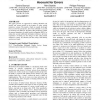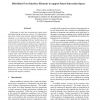FSEN
2009
Springer
14 years 4 months ago
2009
Springer
Although presented with a variety of ‘flavours’, the notion of an interactor, as an abstract characterisation of an interactive component, is well-known in the area of formal ...
UML
2005
Springer
14 years 5 months ago
2005
Springer
This paper presents an approach for relating informed task models and system models in the domain of safety critical interactive systems. The models, which are usually developed f...
ISM
2005
IEEE
14 years 5 months ago
2005
IEEE
In this paper we show how an interactive system can be distributed among several peer devices. By taking advantage of the current trend towards ambient intelligent environments, w...
ACMDIS
2006
ACM
14 years 5 months ago
2006
ACM
Human-computer interaction research often includes a significant design component. In cases where software or other tools are developed and described, but no empirical evaluation ...
ACMDIS
2006
ACM
14 years 5 months ago
2006
ACM
Human-Computer Interaction (HCI) is defined by the Association for Computing Machinery (ACM) Special Interest Group on Computer-Human Interaction (SIGCHI) as “a discipline conce...
ACMDIS
2006
ACM
14 years 5 months ago
2006
ACM
ACMDIS
2006
ACM
14 years 5 months ago
2006
ACM
Reusing HCI design knowledge shows potential in allowing practitioners to design based on previously identified concerns. A reuse approach is presented that is based on claims, de...
ACMDIS
2006
ACM
14 years 5 months ago
2006
ACM
Storyboarding is a common technique in HCI and design for demonstrating system interfaces and contexts of use. Despite its recognized benefits, novice designers still encounter ch...
ACMDIS
2006
ACM
14 years 5 months ago
2006
ACM
Human-Computer Interaction (HCI) often focuses on how designers can develop systems that convey a single, specific, clear interpretation of what they are for and how they should b...
ACMDIS
2006
ACM
14 years 5 months ago
2006
ACM
Recent research suggests design pre-patterns, structured collections of evidence-based research and design knowledge, provide a useful resource for design activities in emerging a...



